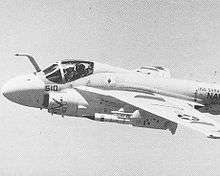Second VA-75 (U.S. Navy)
| Bombing Squadron 18 & Attack Squadron 75 | |
|---|---|
|
VA-75 insignia | |
| Active | July 20, 1943 – February 28, 1997 |
| Country | United States |
| Branch | United States Navy |
| Type | All Weather Attack |
| Part of | Inactive |
| Nickname(s) | Sunday Punchers |
| Engagements |
World War II * Philippines campaign (1944–45) * Battle of Leyte Gulf Korean War Cuban Missile Crisis Vietnam War Operation Desert Storm Operation Southern Watch Operation Deny Flight |
| Aircraft flown | |
| Attack |
A-1 Skyraider A-6 Intruder |
| Bomber |
SBD Dauntless SB2C Helldiver |
| Fighter | F4U Corsair |
Attack Squadron 75 (VA-75 or ATKRON 75) was an attack squadron of the United States Navy that was active from World War II through the 1990s. It was the second squadron to carry the VA-75 designation. Nicknamed the "Sunday Punchers," they were based out of Naval Air Station Oceana, Virginia. The squadron flew combat missions during World War II, the Korean and Vietnam Wars and saw its last action during the Gulf War in 1991. They were the first fleet squadron to get the A-6 Intruder and the last unit to fly it in operational service. VA-75 was deactivated as part of the post-Cold War drawdown of forces on February 28, 1997.[1]
History


The squadron was established as Bombing Squadron EIGHTEEN (VB-18) on July 20, 1943. Redesignated Attack Squadron VA-7A on 15 November 1946. Redesignated Attack Squadron VA-74 on 27 July 1948. Redesignated Attack Squadron VA-75 on 15 February 1950. They were the second squadron to be assigned the VA-75 designation.
“Between 7 September and 25 November 1944, Bombing Squadron Eighteen (VB-18), the “Sunday Punchers” of the Third Fleet, flew 526 sorties in support of landings on Palou and Leyte, in raids on Formosa and Nansei Shoto, and against Japanese Battleship and Carrier Task forces in the Second Battle of the Philippine Sea. During these actions Helldiver pilots of Bombing Eighteen sank or assisted in sinking a medium carrier, three minelayers, a destroyer escort and ten merchantmen; probably sank or seriously damaged three battleships, another medium carrier, a light cruiser and thirty-four merchant chips. Enemy cargo ships and transports sunk or damaged totaled 171,060 tons. In aerial combat eleven enemy planes were shot down while 35 were destroyed on the ground and 38 damaged. Important ground targets destroyed or damaged by bombing and strafing included 27 hangars, 65 barracks, warehouse and factories, 5 anti-aircraft positions, 4 fuel and 2 ammunition dumps. From these operations 10 pilots and 13 aircrewmen are missing and one enlisted man was killed during an attack on the Squadron’s carrier. Two pilots and their aircrewmen, shot down over enemy territory, are known to be with friendly forces. One pilot and a ship’s photographer returned to base after nine days on a life raft. In a series of far-flung attacks which carried the “Sunday Punchers” from Peleliu to within 200 miles of the Japanese mainland, 961,200 pounds of bombs were dropped, 50,610 rounds of 20mm and 37,544 rounds of 30 calibre ammunition were fired.”[2]
See also
- History of the United States Navy
- List of inactive United States Navy aircraft squadrons
- List of United States Navy aircraft squadrons
References
This article incorporates text from the public domain Dictionary of American Naval Aviation Squadrons.
- ↑ Grossnick, Roy A. (1995). Dictionary of American Naval Aviation Squadrons, Volume 1, Chapter 2, Section 5: Attack Squadron Histories for VA-64 to VA-75 (PDF). Washington, D.C.: Naval Historical Center, Department of the Navy. pp. 132–137. Retrieved 2014-02-16.
- ↑ Source: US Pacific Fleet Publicity Material: ComAirPac Restr. Ltr. FF12-5/A7-1/me/Ser.No. 13602 dated 6 November 1944
Notes
Bibliography
External links
| Wikimedia Commons has media related to Attack Squadron 75 (United States Navy). |
- VA-75 Sunday Punchers dedication and reunion site
- VA-75 Sunday Punchers CVW-7, CVA-62
- VA-75 Sunday Punchers @ the Intruder Association
- The Sunday Punchers
.gif)
